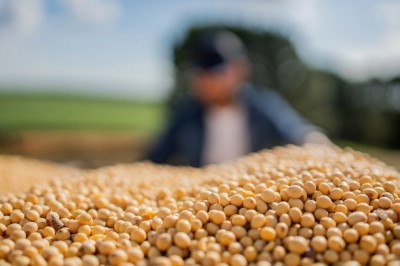UK agri-food sector faces complex compliance hurdles with new deforestation rules

One challenge is ensuring the smooth flow of data while maintaining compliance with GDPR as they prepare for EU Deforestation Regulation (EUDR), according to Dr Annie Williams, animal nutrition specialist and UK Agri-Tech Centre business development manager.
Demonstrating compliance, particularly for trade involving embedded goods, also presents difficulties. Additionally, mapping supply chains and assessing risk are essential but onerous tasks, she notes.
The UK Agri-Tech Center recently convened a meeting along with Leprino Foods, Arla, and Agricultural Industries Confederation (AIC) to discuss and agree actions needed to ensure that the UK industry is prepared for the introduction of EUDR.
“Effective communication throughout the supply chain is critical, as everyone must be on the same page—this is a key reason for organizing our event,” Williams tells us.
EUDR - what products are in scope
From January 1, 2025, the EUDR will require organizations placing relevant products, notably soy, palm, and beef, onto the EU market to prove that their goods do not originate from recently deforested areas or contribute to forest degradation.
Companies exporting any of the affected commodities into the EU will need to demonstrate they have carried out due diligence checks to confirm that the products have not been sourced from land which was deforested or degraded after December 31, 2020.
Whilst the focus is on the major commodity traders, the regulation also applies to farmers and processors who are placing beef on the EU market. There is a requirement to provide evidence of soy and palm feed sources, with obligations for SMEs delayed until 30 June 2025.
Dairy products are specifically excluded from the scope of the regulation; however, dairy producers could be affected where dairy cattle are slaughtered for beef and that beef is exported to the EU. Pork, poultry and eggs with embedded soy are also excluded from EUDR obligations.
UK rules
Alongside EUDR, the UK government is expected to introduce the UK Forest Risk Commodity Regulation (UKFRC) in 2025.
The UKFRC will reportedly differ in scope from the EUDR, and many commentators believe that Defra is not planning to bring it exactly in line with EUDR, meaning that stakeholders would need to prepare for more than one set of legislative requirements.
The alignment, or lack thereof, between EUDR and UKFRC could significantly impact the industry’s preparedness, warns Williams.
Understanding which regulation will be required, and whether different supply chains will necessitate different compliance measures, is crucial, she adds.
"Essentially nobody wants to do two sets of paperwork or more than they need to,” remarks Williams.
Failure to achieve compliance with EUDR and UKFRC regulations could have long-term impacts on UK agriculture, particularly in terms of market access, which is a major concern for the industry, she claims.
Key [potential] differences in scope between the UKFRC and the EUDR
The AIC has published an FAQ on this topic.
James McCulloch, AIC head of feed, sees some positive elements in the likely divergence between the two sets of rules.
He says the lack of convergence between the UKFRC and the EUDR is inevitable, but along with challenges, this fact could also create opportunities for some sectors.
"For example, there are potential opportunities for improved EU market access and competitiveness for UK pork, poultry and eggs supply chains because these commodities are not in EUDR’s scope."
Primary challenges for UK feed producers
While the EUDR does not directly apply to beef and dairy supply chains in Great Britain, the primary challenge is a need for compliance if in-scope commodities are destined to be sold in the EU, reports McCulloch.
"It is thought that current traceability systems in place in GB for cattle will provide the evidence needed to demonstrate compliance with EUDR. However, the requirement will impact feed producers because while feed from GB compounders does not need to be EUDR compliant, some downstream customers will require this, potentially creating a more complex and fragmented customer base.
"Meanwhile, it is thought that feed producers in Northern Ireland will need to comply with both EUDR and UKFRC, which adds further complications for these businesses. Introducing these separate and varying requirements adds complexity, which brings added cost," the AIC feed lead tells FeedNavigator.
That trade group is developing standards to support UK feed businesses in demonstrating that they have provided sufficient evidence to auditors to suggest they would be compliant with each set of regulations and provide the transparency that downstream customers require, he outlines.
In July, the Retail Soy Group (RSG), a coalition of food retailers, stressed that continued inaction on UK legislation in this space risks the UK becoming a dumping ground for commodities linked to deforestation.
UK proposals 'appear more pragmatic' than EU rules
But how regulations are implemented and how the competent authorities enforce them might prove an issue, states McCulloch.
"For instance, under the EUDR, there are potentially 27 different competent authorities (one for each member state) enforcing the regulations, presenting a risk of inconsistent interpretation of the rules from country to country. This could be a challenge for EU market access and a potential frustration for UK beef and dairy supply chains.
"The secondary legislation and guidance on UKFRC are yet to be published, but the UK proposals appear more pragmatic on the requirement for demonstrating compliance. At present, we don’t anticipate any long-term challenges as we expect UK feed producers to be able to demonstrate that they have taken the proportionate action required to demonstrate UKFRC compliance. However, the secondary legislation and guidance, when published, might challenge this view."
Market requirements for transparency
Ben Williams, sustainability manager, Leprino Foods, also commented on the new rules:
"Whilst the dairy sector has no immediate legal obligation to report feed sources and standards under UKFRC (not yet legally ratified) or EUDR, we recognise the moral obligation and market requirements for transparency and the highly integrated nature of dairy and beef supply chains."
He stressed how vital it is that dairy and beef supply chains maintain market access both in the UK and EU, saying there was a need for rapid and collaborative action.
In June, a post by Strutt & Parker's rural experts outlined what the EUDR means for UK farming and forestry sectors.













